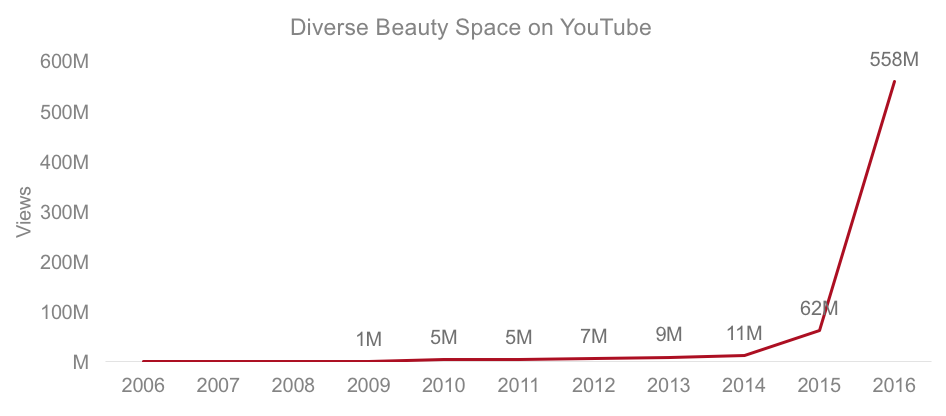
On YouTube, the Diverse Beauty Space is Thriving
On social video platforms, beauty is booming, and one sub-category in particular is rapidly building momentum: diverse beauty. While beauty brands have largely marketed toward women in the past, male, transgender, or gender-nonconforming beauty creators command massive audiences online today, and these creators are turning that influence into partnerships with beauty brands.
Pixability’s data shows that the diverse beauty space is fast gaining steam, growing by 9X in 2016 over the previous year. In total, the space has over 740M views across 7K channels and 21K videos, which were shared over 1M times on Facebook. While diverse beauty represents only .6% of the beauty category on YouTube, this niche is growing more than 13X as fast as the overall beauty space.

Brands are waking up to fact that these influencers shape beauty culture through their mastery of makeup:
- Manny Mua, a male beauty influencer that boasts 3.2M followers on Instagram, and 2.3M subscribers on YouTube, was recently named Maybelline’s first male brand ambassador, and is the star of the brand’s “That Boss Life” campaign.
- James Charles is the first male face of Covergirl, and will be at the center of the upcoming CoverGirl blastPRO Mascara campaign. He has 754K subscribers on YouTube, and 1.4M followers on Instagram.
- Hari Nef, a transgender actress, model, and activist, has over 177K followers on Instagram. She’s the star of a L’Oréal Paris ad campaign celebrating the beauty of diversity that premiered during the Academy Awards.
- Male beauty influencer Patrick Starr has over 2.1M YouTube subscribers and 2.8M Instagram followers, and has had significant success at translating digital fame into brand partnerships. This year, Anastasia Beverly Hills kicked off a collaboration with Starr to release an 18-shade lip palette.
These partnerships, and the subsequent exposure through mainstream media, will likely further fuel the already explosive growth of diverse beauty on YouTube.
Beauty brands have an opportunity to tap into this largely-underserved market by joining the conversation around diverse beauty. By creating content around emerging trends, brands can better position themselves to drive visibility as the trend continues to take off. Additionally, Pixability’s beauty study illustrated that by partnering with beauty influencers for branded content, or by targeting paid media against influencer’s videos and channels, beauty marketers can drive advertising performance.
Beauty marketers — will you make diverse beauty part of your media strategy in 2017?
If you’d like to connect to learn more about how Pixability’s social video advertising solution can help you or your client’s video advertising, get in touch today.